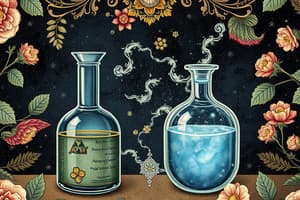Podcast
Questions and Answers
Define Molecule:
Define Molecule:
A molecule is formed when two or more atoms bond together.
Define Compound:
Define Compound:
A compound is a substance that is formed when two or more different types of atoms bond together.
Which family (Group) are Argon and Neon a part of?
Which family (Group) are Argon and Neon a part of?
Noble Gases
Be able to identify elements (by their atomic number) that are in the same family. Which family (group) contains Iodine, Bromine, and Fluorine?
Be able to identify elements (by their atomic number) that are in the same family. Which family (group) contains Iodine, Bromine, and Fluorine?
Why is the bottom of Group 1 the most reactive of the metals?
Why is the bottom of Group 1 the most reactive of the metals?
Why do the atomic radii of elements reduce from left to right across the periodic table?
Why do the atomic radii of elements reduce from left to right across the periodic table?
Flashcards
Molecule
Molecule
A group of two or more atoms held together by chemical bonds. They can be composed of the same element or different elements.
Compound
Compound
A substance formed when two or more different elements are chemically bonded together in a fixed ratio.
Noble Gases
Noble Gases
The group of elements in the far right column of the periodic table. They have a full outer shell of electrons, making them very unreactive.
Stable Electron Configuration
Stable Electron Configuration
Signup and view all the flashcards
Halogens
Halogens
Signup and view all the flashcards
Atomic Radii
Atomic Radii
Signup and view all the flashcards
Reactivity of Metals
Reactivity of Metals
Signup and view all the flashcards
Atomic Radii Trend
Atomic Radii Trend
Signup and view all the flashcards
Study Notes
Elements and Compounds
- Elements naturally form ions to achieve a complete/stable electron configuration
- A compound is a substance formed when two or more different elements are chemically bonded together
Families and Groups
- Argon and Neon belong to Group 18 (noble gases)
- Elements in Group 18 have a stable electron configuration (complete valence shell)
- Elements are identified by their atomic number
- Iodine, Bromine, and Fluorine are in Group 17 (halogens)
- The bottom of Group 1 (alkali metals) are the most reactive metals because they readily lose an electron to achieve a stable configuration
Atomic Radii
- Atomic radii decrease from left to right across the periodic table because of increasing nuclear charge. The stronger attraction between the nucleus and the electrons pulls the electron cloud inwards.
Studying That Suits You
Use AI to generate personalized quizzes and flashcards to suit your learning preferences.




